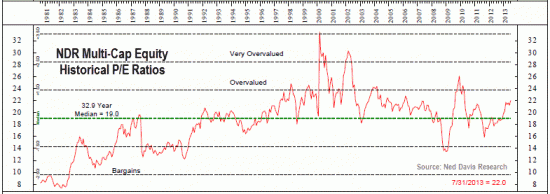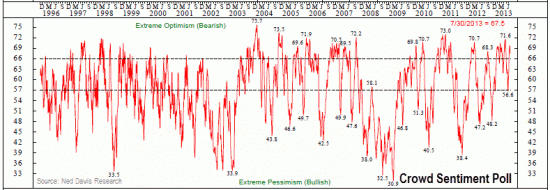What do tulips, Beanie Babies, Barbie Dolls, real estate, stock markets, silver and gold have in common? They have all seen speculative bubbles in their prices that burst with devastating results for investors who believed that there would be no end to their rising prices. Quite a few clients have asked of late if the stock market is in another bubble? The stock market “wobbled” from late May to late June when the media and the markets interpreted Bernanke’s comments to Congress to mean that the punch bowl (AKA, Quantitative Easing (QE)), was going to be tapered off, likely starting in September. While the impact was nominal, with the S&P 500 down only 5.75%, the sell off was swift and sharp – the majority of this sell off occurred over 4 short days.
The markets can be fickle… And sell-offs tend to be abrupt and painful. So, are we in another bubble?
(If you don’t have time to read our newsletter, download the Market Snapshot.)
The Longer Term View The short answer is we don’t think we are currently in another bubble like the ones experienced in 2000 and 2007. Other market professionals may disagree, but we believe that as we move into year-end, the market will likely push higher given:
- The Fed Just last week, Bernanke softened his tone regarding when Quantitative Easing (QE) will be tapered – at least that is how the markets interpreted his comments. As long as we have a “friendly” Fed policy, the markets will likely continue to move higher, albeit with the possibility of pull-back along the way (see below.)
- The Tape Price momentum seems to be on the side of the bulls, at least for now. Price momentum can drive a market long after valuations and logic/reason imply otherwise. This is why we believe in primarily applying a price/momentum-based approach to managing client assets. Our hope is that this type of approach will help leverage the bull market trends and mitigate bear market losses.
- Market Breadth Yes, we have seen a big move over the past few months, but the market’s Price-Earnings Ratio, or P/E, (as represented by Ned Davis Research’s (NDR) Equity Universe, see chart below) is not at the levels of 2000 and 2007, when the ratio was between 26 and 32. As of the end of the quarter, the NDR Universe showed a P/E of 22. That being said, we are above the 32+ year median market P/E of 19, so the stock market as a whole, is not cheap.
But, Over The Short Term… We think the bull has been on a long run, and may need “a rest” before continuing its upward trajectory. Of course, we can’t say for certain a pull back is eminent, but as always, we like to look at the weight of the evidence:
- Crowd Sentiment Crowd sentiment polls are often used by institutional money managers to measure market extremes. As you can see from the chart below, we are currently at “extreme optimism” levels, which tends to be bearish for the markets.
- Market Seasonality As our clients know, we are in the “unfavorable season,” the months during which the market typically exhibits greater volatility and/or “offers up” a pull-back. While this phenomenon does not hold true every year, it is useful to bear in mind when markets appear to be at extremes.
- Market Volatility What volatility? Market volatility, as measured by the VIX (iPath S&P 500 Short-term Volatility Index), has been on a steady decline, closing Friday at 14.25. The market goes in cycles – market volatility, like prices, have cycles. Volatility at these low levels indicates too much optimism, and is likely not sustainable.
Again, we can’t say for certain that the markets will pull back, we think the combination of factors above puts the probability of this occurring as “higher rather than lower,” before a likely move up into year-end.
What To Do Next?
With all of this said, we think investors may want to consider dividing their thinking into two camps:
- Investment Portfolios (Offensive) These are assets that are invested in the market for the longer-term. This doesn’t mean that you “buy and hold” at all cost – you still have a “Plan B,” a sell discipline, if you think we are heading into a bear market. This does mean, however, that if you are currently invested, you likely stay invested. However, if you have new money to invest, we believe caution may be warranted until we see a pull-back or until we enter the “favorable season” in mid-to-late October.
- Tactical Portfolios (Defensive) Most investors have traditionally used bonds as their primary portfolio risk-management tool. With interest rates at near-historic lows, we don’t think it is the time to apply bonds as your main risk-mitigation approach. Rather, we believe that a a disciplined, methodical, pro-active approach to managing portfolio risk may ben an approach worth considering.
If you would like to chat about any of the above, please give us a call.
– Roberta
Information contained herein is for informational purposes only and is subject to various interpretations and time-frames, and should not be considered investment advice. Advice may only be provided after entering into an advisory agreement with Alexis Advisors, LLC (“Advisor.”) Advisor does not assume any legal liability or responsibility for any incorrect, misleading or altered information contained herein. Advisor shall not be liable for the improper or incomplete transmission of the information contained in this communication. Past performance is not indicative of future results while changes in any assumptions may have a material effect on projected results. Third Party Research Disclaimer: Third party research is provided for information purposes only and has not been prepared by Alexis Advisors, LLC. The information contained herein is based upon sources which we believe to be reliable, but no representation, express or implied, is made with respect to the accuracy, completeness or reliability of the information or opinions in the reports. About: Alexis Advisors, LLC is a Registered Investment Advisor with the Commonwealth of Virginia. Advisor’s current Disclosure Brochure is set forth on Form ADV Part 2 and is available for your review upon request. Please contact Advisor promptly if there are any changes in your financial situation or investment objectives, or if you wish to impose, add or modify any reasonable restrictions to the management of your account.


